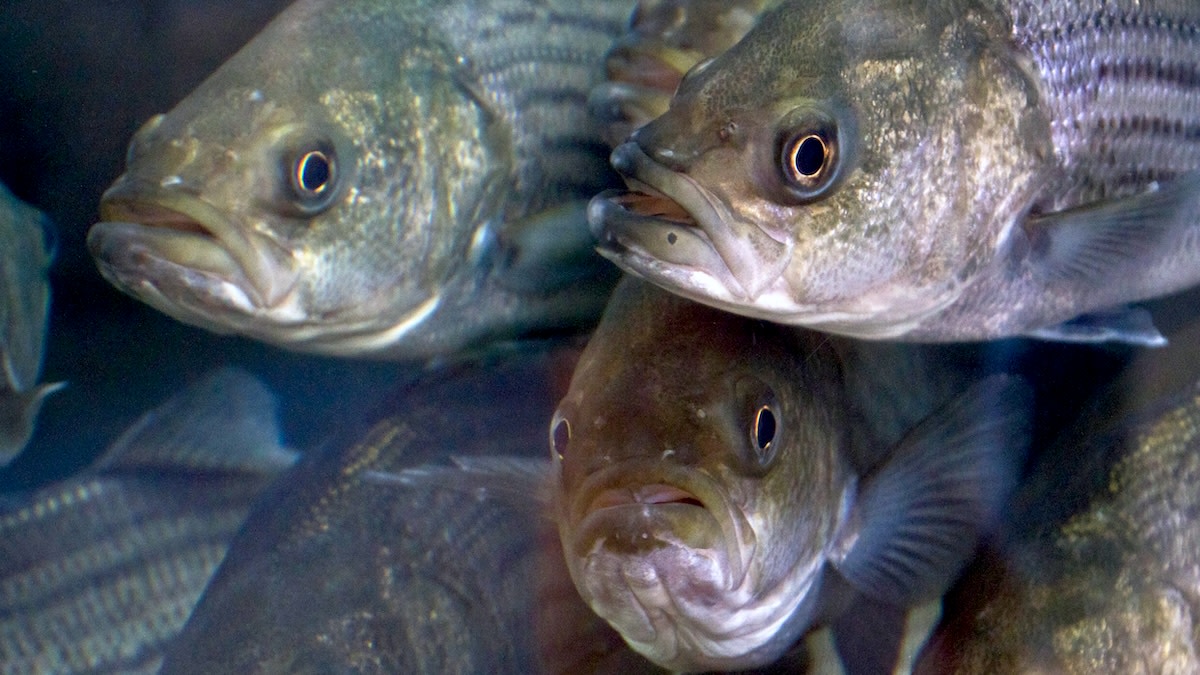
One of America’s most iconic fish species is in continued decline, new data shows. In the Chesapeake Bay, biologists are reporting that this year’s striped bass spawn was dismal—for the sixth straight year in a row. The Bay is the largest spawning area for stripers on the entire East Coast, and it’s news that doesn’t bode well for the future of the species.
The data is based on a survey conducted in the Bay every summer. It involves setting a 100-foot seine net at 22 locations along beaches and estuaries to capture newly-hatched juvenile bass. The youngsters—about three inches long—live in shallow, near-shore habitats where food is abundant and riparian vegetation provides protection from predators. Each site is sampled three times per summer. The average number of fingerling bass caught in the nets gives biologists a good idea of how successful the spawn was.
This year, the young-of-year index for Maryland was 2 fish per sample and 3.4 fish per sample in Virginia. Those numbers are down significantly from the long-term averages for each state: 11 for Maryland and 7.7 for Virginia. Still, it’s a slight improvement from last year, in which Maryland reported an average of just 1 fish per sample. The number has been below 3.6 since 2019.
Biologists are pointing to a series of warm, dry winters as the primary driver in the decline. Less rainfall decreases springtime flows in the freshwater tributaries where the bass spawn. Additionally, the zooplankton that juvenile bass consume are cold-water species, resulting in poor alignment between the striped bass spawn and zooplankton blooms. To compound things further, the yearling bass are extremely sensitive to changes in environmental conditions—which the Bay has been seeing more of in recent years in terms of overall water temperatures.
“The zooplankton peak before the fish are spawned,” Harry Hornick, DNR program manager for striped bass said in a press release last year. “After the striped bass larvae hatch, there is not enough prey for them to eat and timely first feeding is critical to their survival at an early stage.”
In response to the continued decline in recent years, the Atlantic States Marine Fisheries Commission (ASMFC)—which manages recreation and commercial harvest along the entire East Coast—reduced the ocean slot limit to one fish, 28 to 31 inches long, in January of 2024. They also reduced the Chesapeake Bay limit to one fish between 19 and 24 inches long (per usual, however, check the local regulations before fishing for stripers).
“We have to conserve and build the population to take advantage of the more favorable conditions in the years they occur,” said Eric Durell, a Maryland DNR striped bass biologist. Even so, he said, it’ll take cold, wet winters for the population to rebound.
For years, East Coast states have grappled with how to conserve striped bass while still allowing for fishing of the iconic species. But there’s no doubt that fishermen are a big part of the problem. According to a report this year by the ASMFC, recreational harvest makes up 49% of all bass mortality on the coast, and recreational release mortality makes up an additional 40% of mortality. Commercial harvest is only responsible for 10%. The report concludes that stripers are being overfished along the entire coast. It’s a reality that most anglers already recognize in the form of tougher days on the water.
In response, some organizations have already taken action to reduce harvest. In 2020 the fabled Martha’s Vineyard Striped Bass and Bluefish Derby removed the namesake bass from competition—and not for the first time. In 1985, the board pulled bass from the derby when they were once again on the brink of collapse. The species was reinstated in 1993, however, which highlights the fact that the fish’s population can rebound relatively quickly when given the chance. Today, bass are still out of the competition and will likely remain so for the foreseeable future.
As far as the future goes on the management side of things, the ASMFC board met at the end of October to discuss the status of the striped bass fishery. At the meeting, they concluded that an additional 15% reduction in fishing mortality is required for striper populations to have a 50% chance of rebuilding to sustainable levels by 2029. They will meet again later this month to determine how exactly to do that. Stay tuned for updates.
Shop
Sign In or Create a Free Account
Related

Wildlife Management
Survey Shows Dismal Striped Bass Survival In Chesapeake Bay

Fishing
How to Catch Spring Striped Bass




Conversation